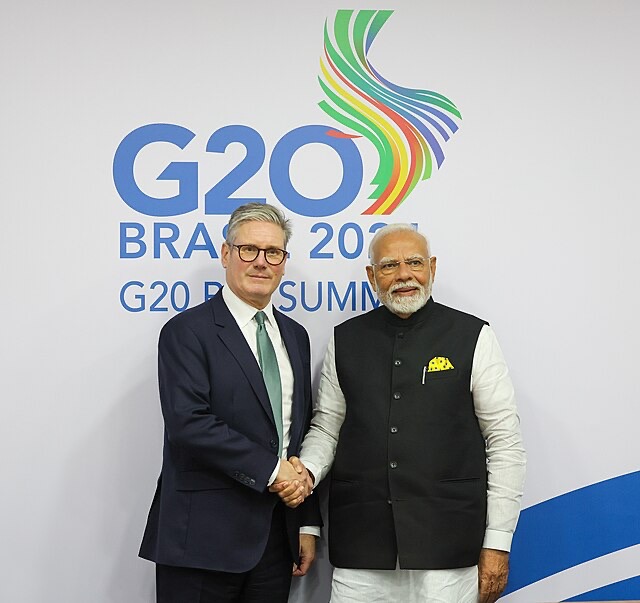Historic UK-India Trade Pact Finalized
In a historic move, the United Kingdom and India have finalized a comprehensive Free Trade Agreement (FTA) poised to redefine economic ties between the two global powers. Announced on May 6, 2025, the deal is being celebrated as the most significant UK trade achievement since Brexit—one that could add £25.5 billion ($34 billion) to bilateral trade by 2040.
Deal Signed as U.S. Tariffs Stir Global Economic Tensions
The timing is no coincidence. The agreement comes just weeks after U.S. President Donald Trump launched sweeping global tariffs, sparking fears of another trade war. The UK and India, both affected by Trump’s protectionist policies, have responded with a pact that signals a growing economic realignment.
What’s in the Deal?
Massive Tariff Cuts on Whisky, Cars, and Medical Goods
Under the new agreement, India has agreed to slash tariffs on UK exports, including:
- Whisky: Down from 150% to 75%, then gradually to 40% over 10 years.
- Cars: Reduced from over 100% to 10% under a quota system.
- Medical Devices, Cosmetics, Aerospace Products: Tariff reductions to enhance UK competitiveness in key sectors.
These cuts are expected to give British exporters significant advantages in the growing Indian consumer market.
UK Concessions on Indian Textiles and Business Visas
In return, the UK will eliminate tariffs on Indian textiles and apparel, making them cheaper for British consumers. While there are no changes to immigration quotas, the deal includes simplified visa processes for Indian business professionals, easing workforce mobility between the two nations.
Economic and Political Context
Trump’s ‘Liberation Day Tariffs’ Push UK and India Closer
Trump’s April 2025 tariff policy introduced a 10% blanket tariff on all imports, with targeted increases for specific countries. India faced a 26% tariff, and the UK was hit with 10%. These measures pushed both nations to fast-track negotiations that had stalled since 2022.
Brexit and Global Trade Realignments Accelerate Deal
Since leaving the European Union, Britain has sought to diversify its trade portfolio, looking eastward for stronger ties. For India, the deal represents an opportunity to counterbalance U.S. trade pressure while advancing Prime Minister Narendra Modi’s ‘Make in India’ manufacturing push.
Who Benefits?
UK Exporters Eye £25 Billion Boost by 2040
UK companies across the spirits, automotive, pharmaceutical, and tech sectors are expected to benefit enormously. Economists forecast an annual boost of £5 billion to the UK economy.
Indian Manufacturers Gain Greater Access to UK Market
Meanwhile, Indian exporters—particularly in textiles and light manufacturing—will gain enhanced access to British retailers, boosting production and job growth in key states like Gujarat, Tamil Nadu, and Maharashtra.
Visa and Workforce Flexibility
No Mass Immigration Changes, but Business Travel Eased
The deal does not include new immigration quotas, but streamlines visa processing for Indian businesspersons and professionals. This aims to support multinational operations, tech partnerships, and temporary assignments without significantly altering immigration policy.
Social Security Agreement Signed Alongside Trade Deal
The two nations also inked a social security pact, which allows professionals working across both countries to avoid double contributions—a win for employees and employers alike.
Leaders React
PM Keir Starmer: “Proof Britain Can Still Lead on Trade”
UK Prime Minister Sir Keir Starmer called the agreement “proof that Britain, post-Brexit, remains a leader in global trade.” He emphasized its importance in “delivering real economic benefits in a turbulent world.”
Modi Hails Strategic Partnership and Job Growth
Indian Prime Minister Narendra Modi celebrated the deal as a “milestone for India’s economic future,” pledging it will create thousands of new jobs and cement India’s role as a global trade hub.
What It Means for Global Trade
UK and India Take Steps Toward Economic Independence
The agreement reflects both countries’ desire for greater trade sovereignty, amid increasing friction with the United States and shifting global power dynamics.
Shift Away From U.S. Dependency as Tariffs Rise
With Trump’s tariffs looming large, the deal is being seen as a geopolitical hedge—a move that enables both the UK and India to reduce economic reliance on Washington and seek alternate growth partners.
Future of UK-India Relations
From Colonial Past to Strategic Partnership
This agreement is not only economic—it’s symbolic. From a complex colonial past, the UK and India have now established a mutual economic future built on trust and opportunity.
Educational, Cultural, and Tech Cooperation Expected to Grow
Analysts anticipate that the trade deal will open doors for tech collaboration, student exchanges, and joint innovation hubs, especially in AI, green tech, and pharmaceuticals.
Conclusion
A Timely Agreement Signaling New Global Alliances
The UK-India Free Trade Agreement is more than just economics—it’s a strategic pivot. As global alliances shift and economic nationalism rises, this landmark deal represents a blueprint for bilateral cooperation in a volatile world.
FAQs
Q1: What are the key highlights of the UK-India trade deal?
A1: Major tariff cuts on UK whisky, cars, and machinery; UK concessions on Indian textiles; simplified business visas; and a new social security agreement.
Q2: Why did the deal happen now?
A2: The urgency increased following U.S. President Donald Trump’s imposition of new tariffs that impacted both the UK and India.
Q3: Will the deal increase immigration from India to the UK?
A3: No mass immigration changes are included, but business travel and temporary worker visas will be simplified.
Q4: How much is the deal worth?
A4: The deal is expected to boost bilateral trade by £25.5 billion by 2040 and increase UK GDP by £5 billion annually.
Q5: What sectors will benefit the most?
A5: Spirits, automotive, medical technology, textiles, and IT services are expected to gain significantly.



